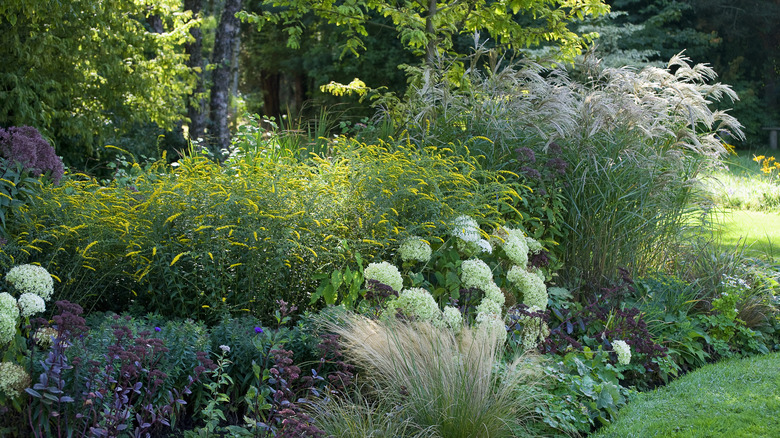The Gardening Trick That Can Help Prevent Weeds From Taking Over Your Yard
No matter how much you pull them or how much mulch you apply to smother them, weeds always seem to find a way into lawns and garden beds everywhere. Even if it were possible to remove or kill every unwanted plant seed in your yard's soil, new seeds would find their way in via dispersal methods like water, bird and animal droppings, and wind. While most wind-dispersed seeds fly hundreds of feet or less before landing, some seeds can travel over 100 miles on the wind. As a gardener, that means blocking the wind is key to minimizing the number of weeds in your yard.
While fences can be expensive and evergreen hedges can take a long time to grow into a solid barrier, creating a windbreak out of ornamental grasses and perennials is both cost-effective and relatively quick. By acting as a barrier to wind and windblown material, this ornamental border can stop airborne seeds from landing in your yard. Weed prevention aside, another advantage of growing ornamental grasses are that they tend to be low-maintenance. Mixing in some easy-to-grow perennial flowers can add color while still keeping your weed-blocking border low maintenance. Just install this mixed border of grasses and flowers so that it spans the length of the edge where most weed seeds seem to be blowing in from. Once it grows in, you'll have a dense border that both blocks weeds from getting into your yard and adds great texture and color to your landscape.
Tips for designing a living weed barrier
To build a gorgeous windbreak with grasses that also effectively blocks seeds, start by identifying the weeds blowing into your yard. Except during storms or strong gusts of wind, wind-dispersed seeds typically float at or around their release height. For example, if a 12-inch tall dandelion releases its seeds, they typically won't float much higher than 12 inches above the ground. If that's the main weed you're dealing with, choosing species for your border that are taller than 12 inches would effectively block most of those seeds from reaching your yard.
Next, plant them close enough together that they can form a dense barrier. This not only improves the border's ability to physically block seeds, but also to shade out and smother seeds that land in it and try to germinate. For windbreaks, it's recommended to aim for at least 50% plant density. This refers to the number of plants in a specified area. So an area of 10 square feet planted at 50% density would have 5 square feet covered with greenery.
But the plants that make up your border still need space to grow and airflow to prevent the spread of disease. So, to make a dense barrier, plant two or more staggered rows, where plants in each row block the gaps between the plants in the previous row. This way, each row has the space the plants need, but the rows together create a multi-layered barrier.

